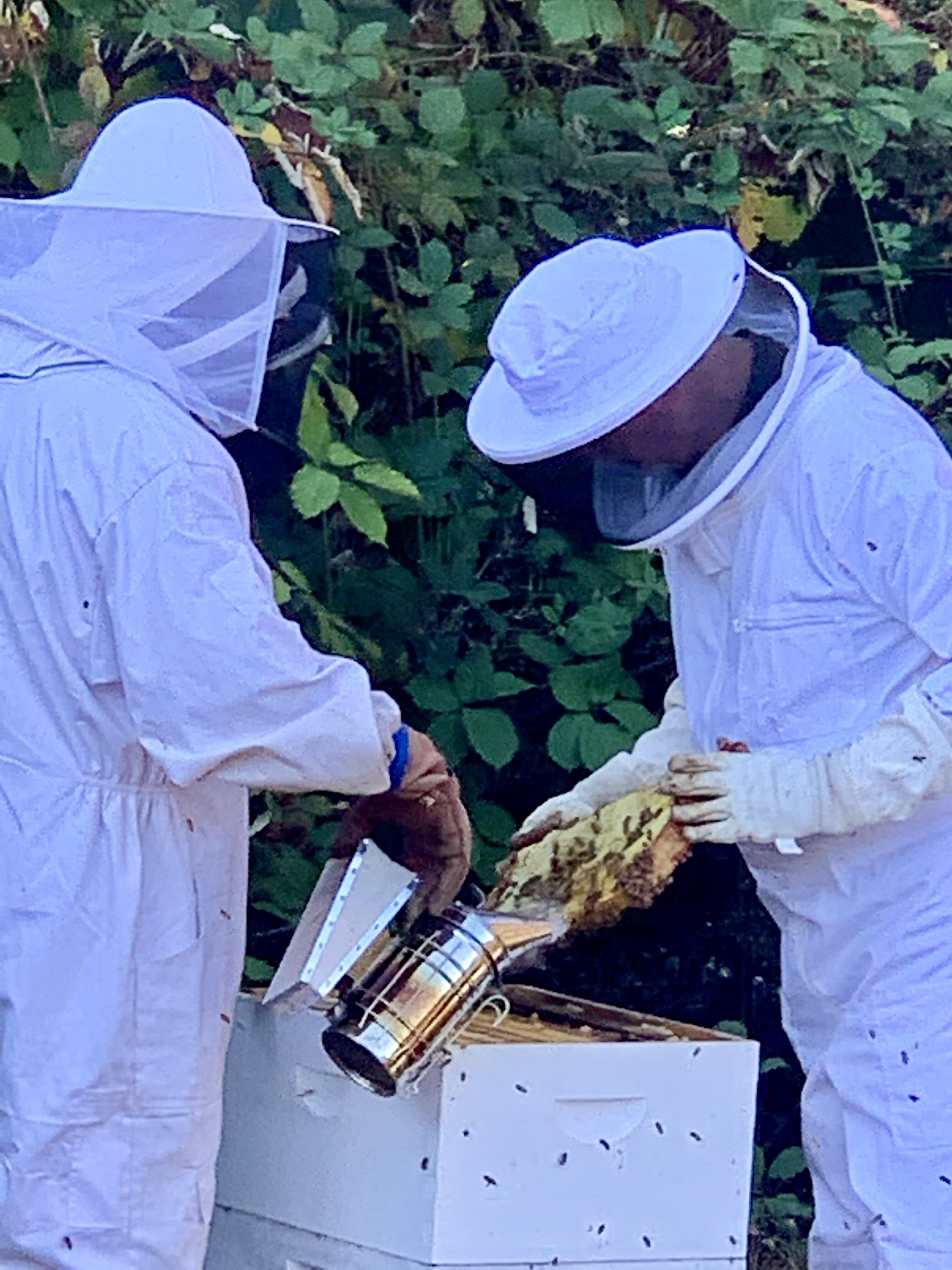 Listen to this story.
Listen to this story.
Bees

Photo by Stephanie Dudley
Though not native to the United States, honey bees are critical to the country's food supply. Veterinarians are new to the field of bee health in the U.S., but with the help of experts, they're learning about the roles they can play in pest management, disease monitoring and more.
Dr. Kristol Stenstrom didn't seek out beekeeping — the bees came to her.
The Kansas veterinarian came home one day in 2016 to find a honey bee swarm had taken up residence on her front porch. In awe but also frightened, she called acquaintances who were familiar with bees. Then, not one to turn down a challenge nor turn away strays — even 30,000 of them — Stenstrom decided to keep the bees.
"It was kind of baptism by fire," Stenstrom said.
Nearly 10 years on, Stenstrom still keeps a small apiary of her own and has incorporated her newfound love of bees into her veterinary practice. She serves as the webmaster and a member of the board of directors for the Honey Bee Veterinary Consortium, a U.S.-based and ‑focused organization with approximately 300 members. The consortium helps educate veterinarians about bees and connects them with knowledgeable beekeepers.
For Stenstrom and other veterinarians concerned with bees, now is a fraught time. Last winter, the domestic honey bee population saw record-breaking colony die-offs — losing more than 60% of U.S. commercial colonies since the previous summer. Initial findings by the United States Department of Agriculture have linked the die-offs to disease-bearing mites that have developed resistance to amitraz, the leading pesticide used against them.
Additionally, on July 24, U.S. Secretary of Agriculture Brooke Rollins released a plan to reorganize the USDA. Part of that plan includes redistributing Beltsville Agricultural Research Center staff and vacating the facility over several years. The center, in Maryland, houses the Bee Research Laboratory, a foremost leader in honey bee research. The USDA has opened a comment period, which closes Aug. 26, for feedback on the plan.
These causes of uncertainty are occurring amid larger conversations about what role veterinarians can play in honey bee health. Honey bee veterinary practice is in a nascent stage in the U.S., and long-timers in the field are trying to shape its growth into what the honey bee industry needs most.
The role of veterinarians in honey bee health
Honey bees are not native to the U.S., but they have become integral to the food system, annually pollinating $15 billion worth of crops, including blueberries, apples and almonds.
Unlike with other livestock such as cattle and poultry, veterinarians in the U.S. have not historically been part of honey bee care. In countries such as Mexico and parts of Europe, honey bee veterinary care is well established, but in the U.S., honey bee health has been managed by mostly nonveterinarian players. They include state departments of agriculture, extension agents, Apiary Inspectors of America, and beekeepers themselves, some of whom bring generations of expertise to the table.
This began to change with the implementation of the 2017 federal Veterinary Feed Directive — a rule requiring a veterinarian's sign-off to administer antimicrobials to livestock, including honey bees.
For the first time, beekeepers looking to give their colonies antibiotics to protect against European foulbrood or American foulbrood — two bacterial diseases dangerous to hives — needed to have a relationship with a veterinarian. The problem was a near-complete lack of veterinarians knowledgeable about bees.
"Some veterinarians were already beekeepers, so their transition to this role was not difficult," said Dr. Chris Cripps, himself both a veterinarian and a beekeeper. "Other veterinarians had more to learn to see how all their core medical knowledge of diagnostic testing, physical examination and treatment applied to bee diseases."
The issue isn't simply teaching veterinarians to be comfortable prescribing antibiotics for hives, said Meghan Milbrath, a beekeeper and assistant professor of apiculture at Michigan State University who teaches veterinary students, veterinarians and veterinary technicians about honey bees.
"I can get someone up to that point in a day," Milbrath said.
The bigger obstacle is training veterinarians to be able to apply their expertise to the unique industry of bees in a way that is a service to beekeepers.
Milbrath, who has a doctorate in environmental health sciences, believes veterinarians can provide insights on nutrition, parasite control, biosecurity plans and more. She said veterinarians also have political clout, which could be helpful to support the bee industry. But she cautions that veterinarians who are new to the world of bees and fail to acknowledge that can struggle to gain the trust of long-time beekeepers.
"I talked to one beekeeper who found a vet that was willing to work with them," Milbrath said. "The vet said, 'I have to come out in person to set up a VCPR [veterinarian-client-patient relationship]. The beekeeper gave them an hour and a half one-on-one in-person lesson on beekeeping, and then the vet charged the beekeeper $150 for the visit. They're like, 'I just had to pay someone for me to teach them about beekeeping.' "
Stenstrom, the veterinarian and beekeeper in Kansas, echoed Milbrath's point.
"Beekeepers have been doing this for a century or more and doing quite well at it without our involvement as a veterinary community, and they know a lot," Stenstrom said. "We are coming in behind, and so quickly, [I] learned that I needed to learn as much as I could and maintain that cordial relationship and not come in as an expert — because I'm not."
Milbrath's work extends beyond educating about bees to include ways to build trust. For example, she hosts hands-on workshops at bee operations, where veterinarians can learn from a beekeeper.
As beekeepers and veterinarians learn to work together, the partnership might serve to make honey bees more resilient against threats to their survival.
A pesticide-resistant mite
To investigate the abnormally high colony die-offs from last winter, the USDA drew on help from the Dyce Lab for Honey Bee Studies at Cornell University, which runs analyses for government labs, nonprofit organizations and members of the public, including beekeepers.
The wait time for such analyses is typically a year. But lab leadership deemed the significance of the die-offs as too important to wait.
"I was able to talk to some of the people that were in our queue for analyses and say, 'Hey, listen, we've got a situation here. There appears to be a big bee loss this year,' " said Scott McArt, associate professor with a doctorate in entomology and program director of the lab.
McArt's team got to work analyzing samples of bees, wax, honey and pollen collected from colonies that died and colonies that were doing well. McArt's lab investigated the role of pesticides, and USDA researchers conducted virus analyses.
Preliminary results, yet to be peer reviewed, were posted on June 1. One of the findings was abnormally high levels of two types of pathogens: deformed wing virus strains A and B and acute bee paralysis virus.
The viruses are vectored, or transmitted, by Varroa mites (Varroa destructor), a notorious parasite of honey bees that is typically treated with the pesticide amitraz. When researchers examined mites taken from collapsed bee colonies, they found the mites had evolved resistance to amitraz.
The finding is in keeping with larger trends.
"The research community has noticed this for about the past 10 years or so, that there is more and more resistance to amitraz in these mites," McArt said. "That's a really big issue, because amitraz is the main treatment that beekeepers use to control the Varroa mites. And Varroa is biological threat No. 1 to honey bees in the United States."
McArt said it will be important to develop new tools to combat the mites and continue educating beekeepers on how to best protect against mites — the latter being a job with which veterinarians can help.
McArt, who teaches a summer course to veterinary students about bees, has seen firsthand the growing interest from the veterinary community and would like to see it develop into more robust relationships between veterinarians and beekeepers.
"How do you move beyond interest and into real engagement so that there's enough engagement that trust is built?" McArt said. "I think that's the step that needs to be taken. We're not there yet."